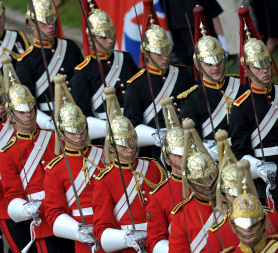Defence review: what next for Britain?
As heavy cuts to the defence budget are announced Michael Codner, director of military sciences at RUSI and former navy commander, writes for Channel 4 News on the implications for Armed Forces.

The issues as to whether the Strategic Defence and Security Review was Treasury or policy led and whether it was conducted in too short a time for proper discussion, and consideration are now in the past. It is the implications and the unanswered questions that matter.
First, the White Paper admits that it is short term review looking to 2015 and the withdrawal from Afghanistan. The real strategic choices are effectively put on hold until the 2015 review.
Secondly defence expenditure will be cut by less than expected, 7.51 per cent over the next four years.
Difficult decisions
But the cuts of capability announced in the document do not in themselves save sufficient money.
There are very, very difficult decisions to be made in the financial Defence Planning Round that is just beginning. And David Cameron assured Parliament in his speech that defence spending will once again increase after 2015 – absolutely necessary if the vision of the review is to be implemented.
Top of the cuts list is the decision, which has taken up a vast amount of the debate in the Cabinet Office and Ministry of Defence in spite of relatively modest savings, to hold in “extended readiness” – i.e. mothball – one of the two carriers to be built, and to equip the second with catapult launched rather than short take off Joint Strike Fighters.
Afghan dominance
And there will be no carrier strike capability in the meantime because the strategic focus is so dominated by Afghanistan – notwithstanding the emphasis in the document on uncertainty, flexibility, prevention and the need to project power and defend the Overseas Territories.
We expected that the Army would lose a good proportion of tanks and heavy artillery and would come back from Germany.
Its manpower cuts will only be 8 per cent compared with 14 per cent or so in the other Services. Yet the requirement for numbers in high readiness brigades has been cut.
The cuts of capability announced in the document do not in themselves save sufficient money.
The big question is Army numbers post-2015 when politicians and the electorate will be keen to avoid interventions with long term troop commitments.
Liam Fox has promised a root and branch review of the Army regimental structure to make more troops available for deployment out of the numbers garrisoned in the United Kingdom at present of the order of 14 per cent.
Special Forces
The emphasis in the Paper on prevention and stabilisation could be read as long term troop commitments in far off places but the meat is in training to build the capacity of nations with weak security rather than endless counter-insurgency.
Another big unanswered question is the role of the Army in particular back at home in countering terrorism and assisting with natural disasters.
Shouldn’t this be a priority as these are Tier 1 threats along with cyber-terrorism espionage and crime?
Special Forces are a capacity that will be expanded. So it is ironic that there could well be cuts in Royal Marines numbers as part of the 5,000 the Royal Navy must lose. And Royal Marines are the largest contributors to both the Special Air Service as well as their Special Boat Squadron.
Carrier cuts
The RAF receives the expected loss of one class of attack aircraft – the Harrier rather than the Tornado which nonetheless will be phased out in the longer term when there will be only Typhoon and the Joint Strike Fighter which the RAF will need carriers to justify.
So for once these two Services are on the same side. And the question is how many light blue pilots will be flying these amazing but costly aircraft from the one or two carriers when they eventually arrive.
Michael Codner is a former Royal Navy commander and Director of Military Sciences at Royal United Services Institute.